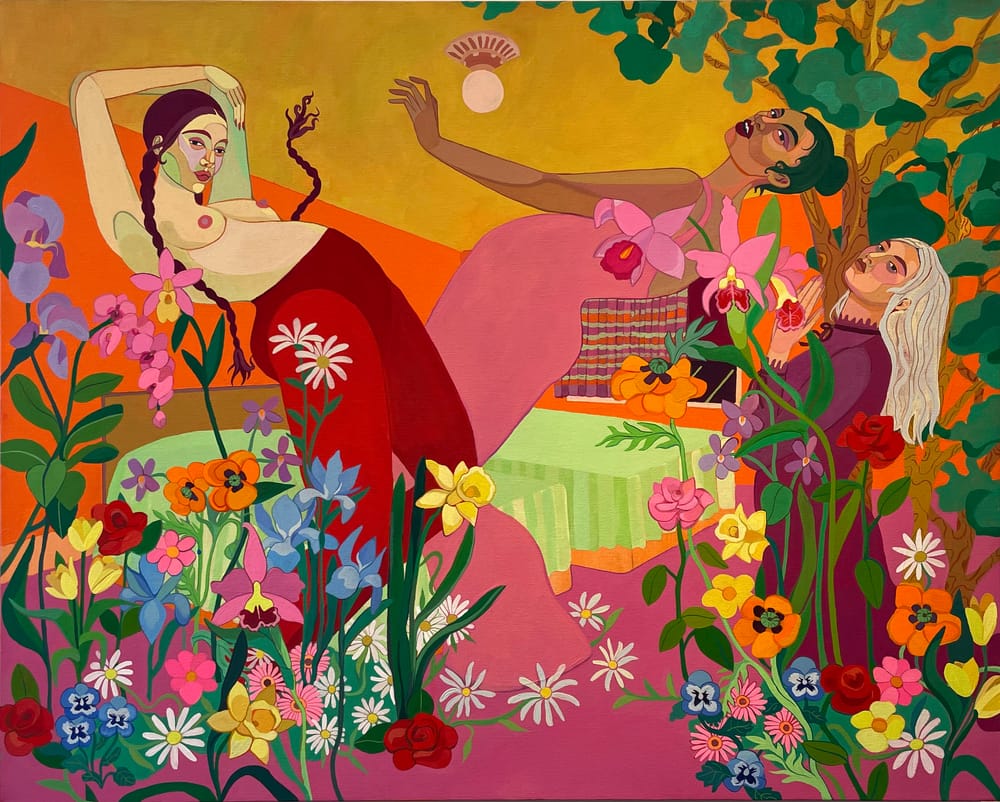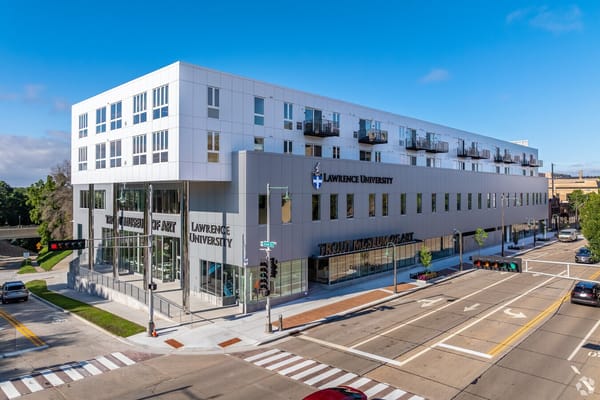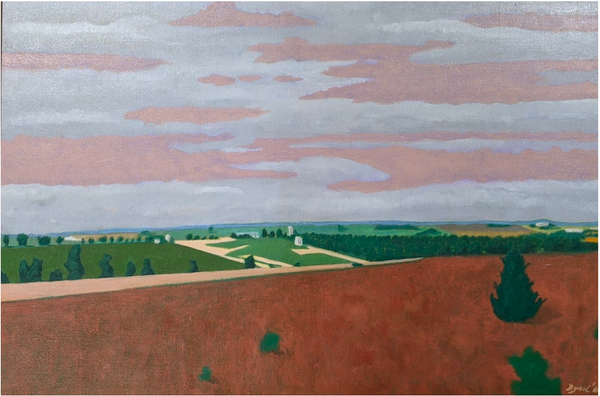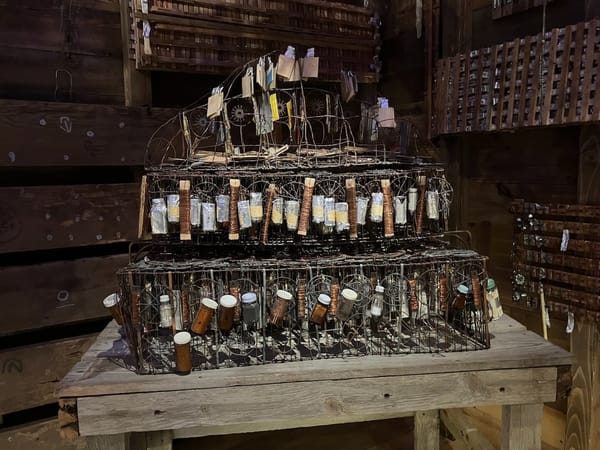Exhibition Review: A Creative Place: Art from Northeast Wisconsin 1940 to Present
by Meghan Sullivan
The exhibition, A Creative Place: Art from Northeastern Wisconsin 1940 to Present, curated by Annemarie Sawkins, is a celebration of the artists of Northeastern Wisconsin. It is also a celebration of the Trout Museum, as this the last exhibition in this location.
Viewing and considering artwork is influenced by where and how you view it. The experience of visiting an artist’s studio versus seeing a piece in a home or in a traditional white cube gallery will influence your reaction. The space around the work, the other artworks in the show, or even whether you have had lunch yet, can change your experience with the artworks. These idiosyncratic galleries put the visitor on a journey through, up, and around. You walk through the spacious first floor gallery, up a grand staircase, down narrow aisleways on the mezzanine level, into a glass elevator where you end up in a warren of galleries on the third floor. Each floor has its own character. It is a quirky space and that demands clever curation and installation. The Trout Museum is using this segmented space to their advantage in this final exhibition.
There are many artworks on display and this is a show that deserves a slow, meandering look. Walking through a few themes resonated for me; landscape, our relationship with nature, and social and cultural concerns of the people living here. The deep legacy of the arts in Northeastern Wisconsin, the role of Door County as an arts incubator, and the importance of local universities is noted in the labeling of the show. Contemplating the recent lay-offs at schools like St. Norbert College and on-going attacks on higher education on a federal level, I was happy to see how the positive influence of our educational systems on this region is reflected in this exhibition. Art must be nurtured and everyone deserves an arts education.
The specific geography of Northeastern Wisconsin and the dichotomies of this particular landscape are explored by several artists. Agricultural interventions imposing order onto vast fields in some works contrasts to the unpredictable wildness of the Great Lakes and protected lands of others. The character of the weather comes through as well. Wisconsin has long, cold, grey winters which lead into a dull, yellow-brown spring that then explodes into the verdancy of summer and then autumn, bittersweet as the weather cools and the days shorten. Austin Fraser’s watercolor, Frosted Barn, captures the scene of a farmhouse in a snowy field. The viewer is held back by a fence running across the bottom of the composition. We are observing the farm but are not a part of it. Whereas in Jerry Dell’s silver gelatin print, Secret Places: Lake Superior, our viewpoint is from the shore, gazing out at the vast expanse of the lake on a clear, calm day. We get to share the secret, at least through the photograph.
Terri Warpinski’s work, Constant Movement: Estuary (Sensiba), captures both the specificity of the landscape and the feeling of late autumn. This large black and white digital print places the viewer in a gently undulating stream surrounded by marsh grasses. Your eye, in following the stream, ends at a dark stand of trees and then suddenly jumps to the top of the composition with its image of a circular swirl of grasses. Reminiscent of a bird’s nest or a grass crown, you are pulled into the circle and to the center of it where the lines become fainter and choppier. Looking at the grasses, we are drawn deeply in, almost as if we are peering into a different dimension. This print evokes the smell and feel of a marsh in late autumn or early spring as you imagine how you would collect the reeds, feeling the cold as you walk down by the stream, with your breath visible in the air.
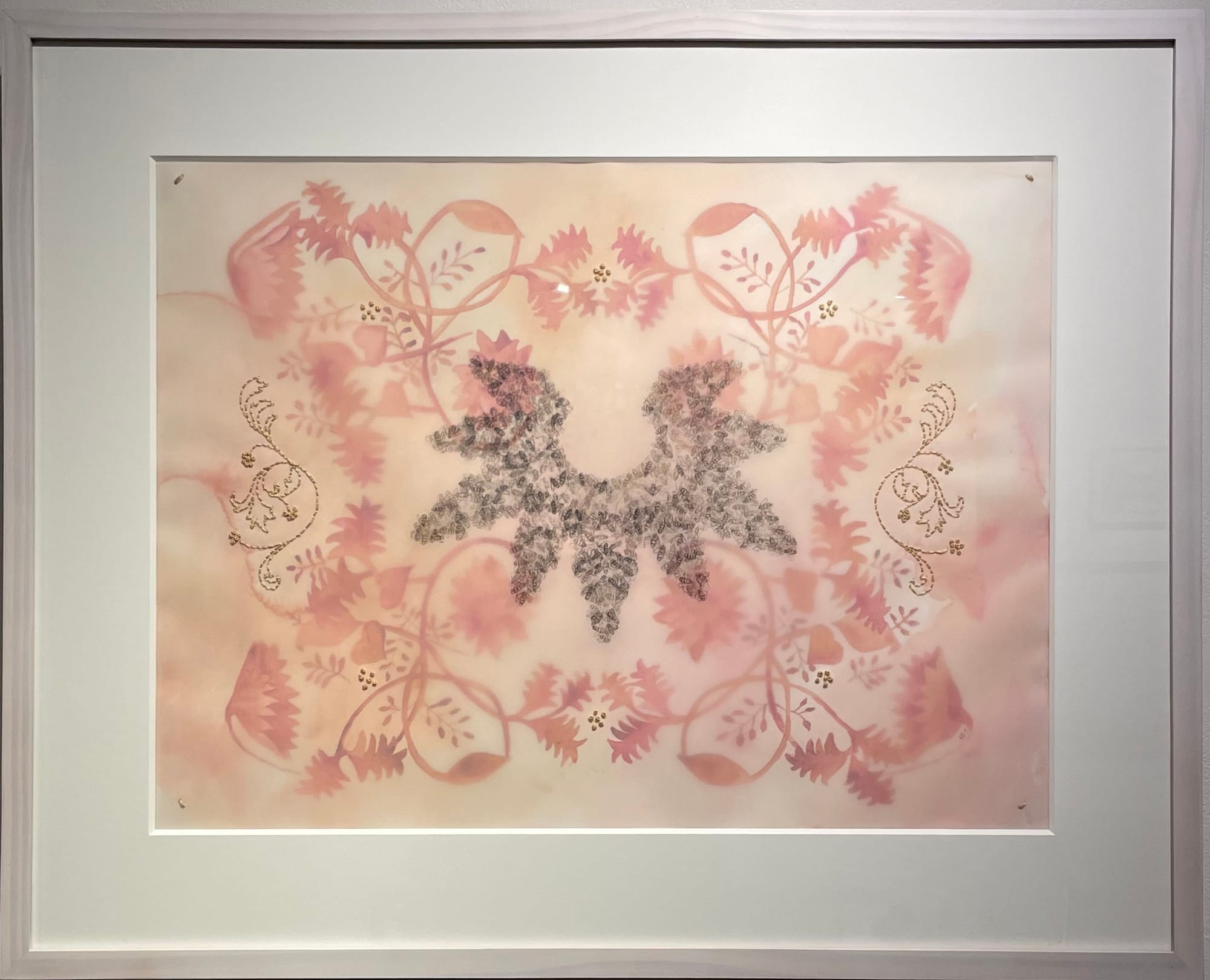
On the second floor, Round and Round by Tony Conrad is placed next to Collar (throat/root) and Cicadas (Heart) by Shan Bryan-Hansen. With these works, you notice how both artists are using repetitive mark making, pattern, and silhouette in works that comment on our relationship with and our desire to control nature. Conrad paints a psychedelic mandala of bright red and green with bullets dotted throughout as part of the pattern. The viewer has to focus to see the ammunition. The repetition and bright colors comment on the violence of hunting but also to the patience and practice of hunting. Shan Bryan- Hanson’s work, in contrast, is soft with almost muted colors. But her repetitive drawings of bees forming a lace collar, speak to the labor of tatting lace and to the collective labor of bees. A swarm of graphite cicadas frames an embroidered flower in Cicadas (Heart). Bryan- Hansen places the buzzing, flying cicadas into a pattern, thus taming and enshrining nature.
Suzanne Rose’s artworks reflects the Northeastern Wisconsin environment through her photographs of vernacular architecture, the not-so-grand everyday buildings that surround us, such as a gas station or a roadside motel. These nighttime photographs, taken in Bloomer, Forestville, and Brussels, WI, evoke the people who use these building through their absence. Each location is desolate but not abandoned. The darkness and spot lighting in these compositions renders the familiar eerie and perhaps, menacing.
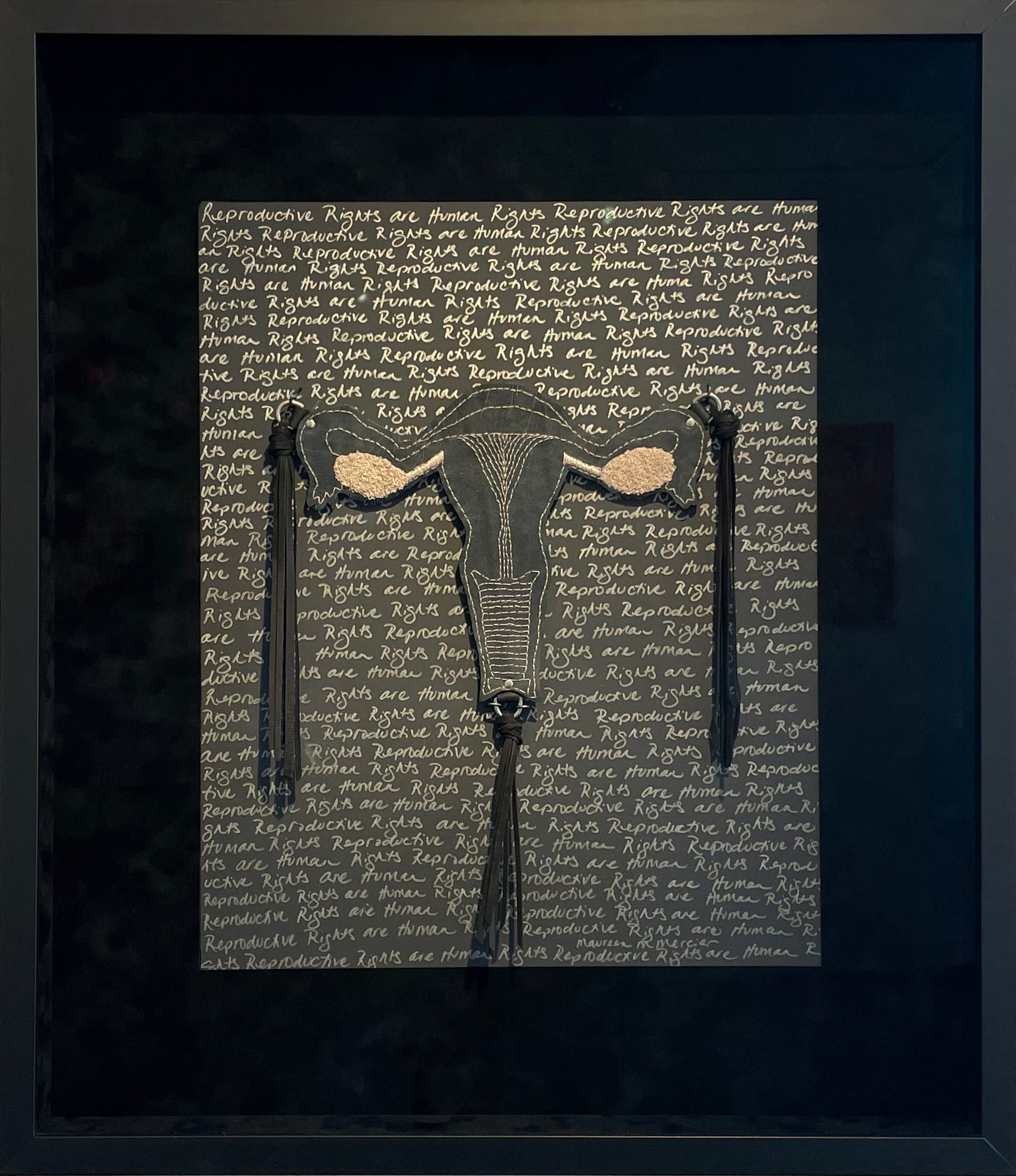
On the third floor, among many other pieces, there is a small area with works addressing themes of gender and power. Michelle Grabner’s, Untitled, might seem like an outlier at first glance. But the abstract, patterned painting of red, white, and pink squares references tablecloth pattern bringing to mind ideas of domesticity and the mundane labor of setting a table. The most overtly political piece in this exhibition is Maureen Mercier’s, My Body, My Choice 2, a mixed media piece. An embroidered representation of a female reproductive system is displayed over the words “Reproductive Rights are Human Rights.” This piece was made in response to the most recent Supreme Court decision eliminating the federal constitutional right to abortion. In the painting, Make Room, by Meg Lionel Murphy, three women are defying gravity, arching their backs, and floating in a small motel room. Colorful flowers and trees are growing around them and framing them in the space. In this room, there is hope and wonder no matter what might be waiting outside. A large-scale photo of a pregnant women in Romero Nance’s, Della, also uses plants and flowers to frame the female figure. Della is in the center of the photo, in a kitchen, looking at an image of flowers. A vining plant hangs over her head as the light pours in from two windows. This piece feels intimate and immediate while also being beautifully composed. The curation in this section feels particularly intentional as the third-floor galleries allow for a more intimate viewing experience.
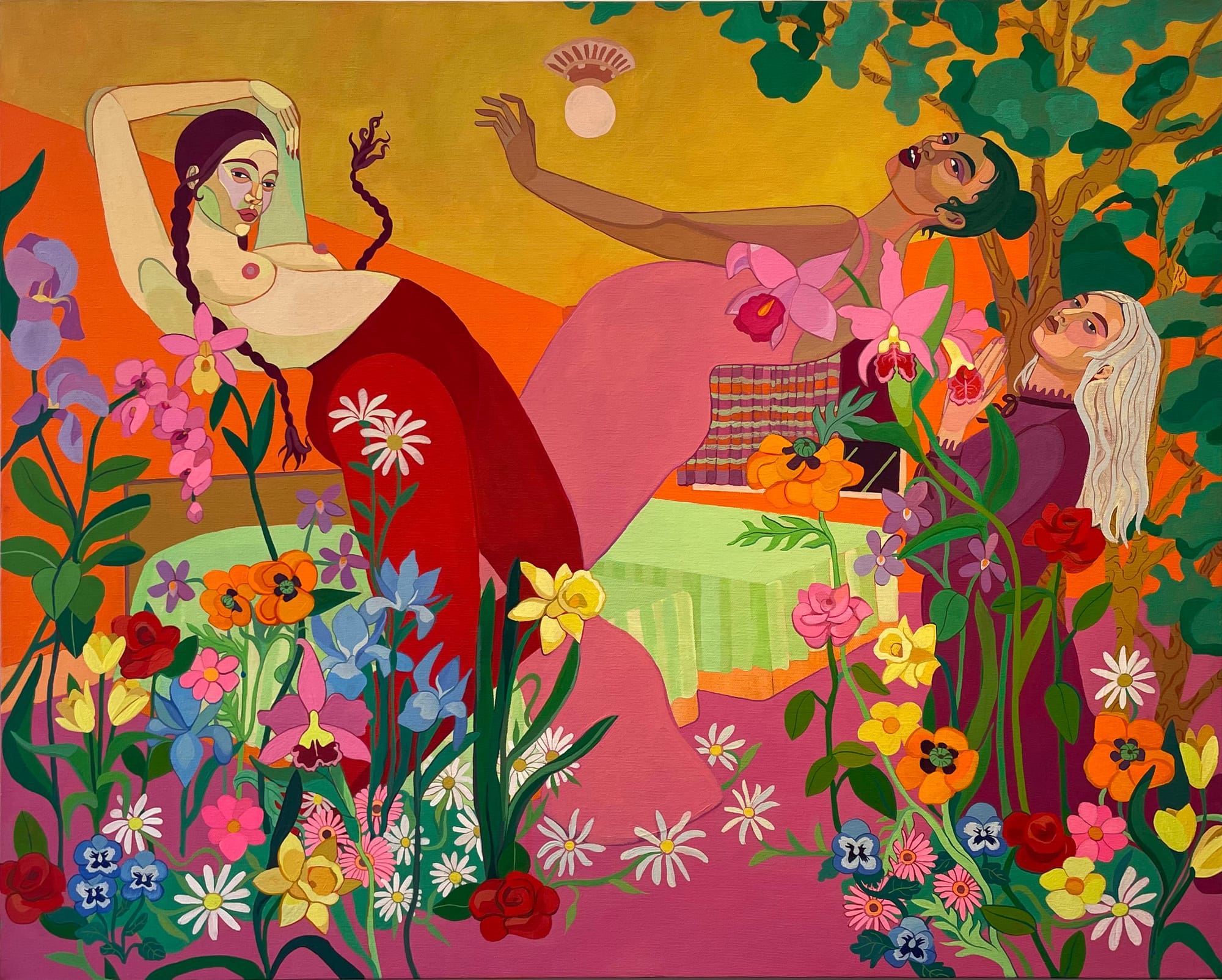
There is so much excellent artwork to linger over in this show. The specific works that I have highlighted are the tip of the iceberg in this terrific exhibition. I would highly recommend that you find the time to visit, wander through the space, find your own themes, and learn more about the arts of our region of Wisconsin. This exhibition closes on May 18, 2025.
A Creative Place: Art from Northeastern Wisconsin 1940 to Present
January 24th–May 18th, 2025
Curated by Annemarie Sawkins
Trout Museum of Art
111 W. College Ave., Appleton, WI
Meghan Sullivan received her BFA from the Massachusetts College of Art and her MFA from the University of Nebraska. She exhibits nationally and internationally. Sullivan has been an artist in residence in many studios, including in Italy and Japan. Sullivan is currently an Assistant Professor of Art at Lawrence University in Appleton, Wisconsin.

